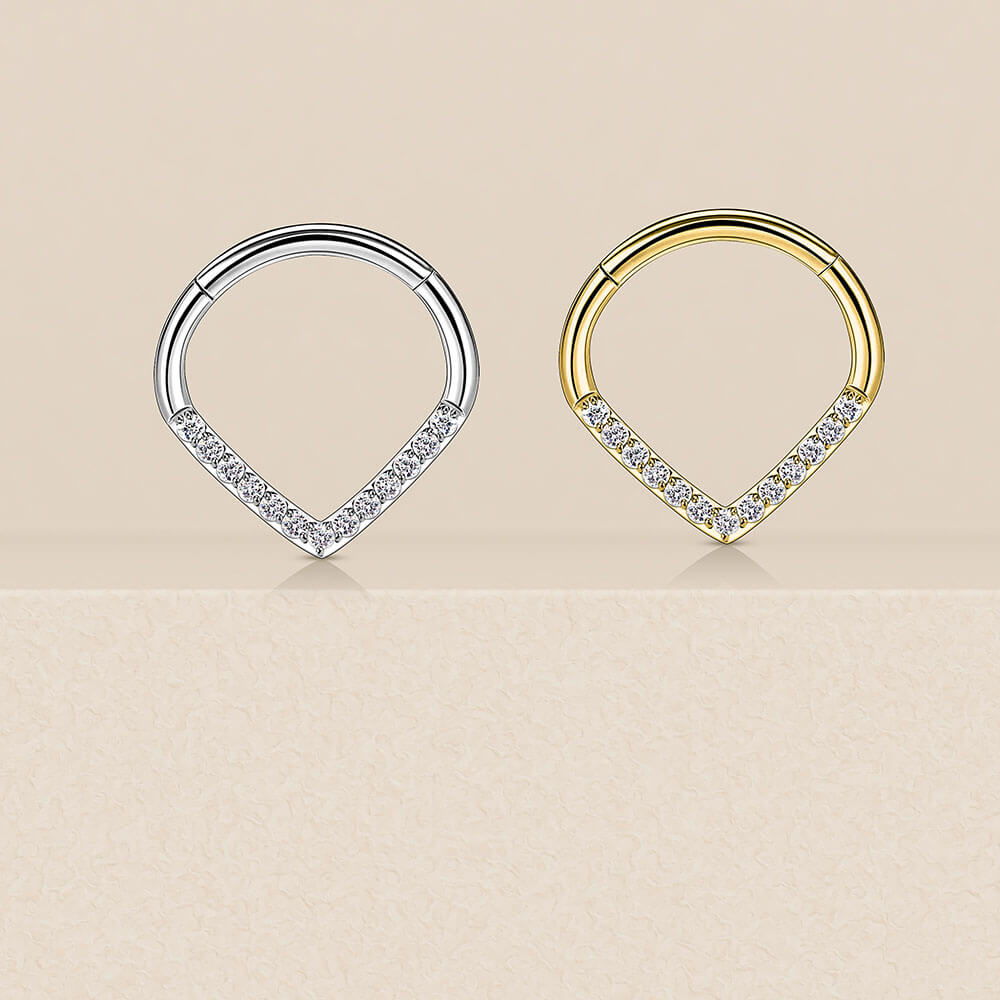
What Body Jewelry Materials are Perfect for Initial Piercings
When you are beginner of piercing, you must want to know which material body jewelry can I used? Only a few material are considered safe for wear in a fresh piercing. A primary consideration is that the jewelry must be able to withstand the heat and pressure of autoclave sterilization; therefore, metal is the most common material for initial jewelry, although plastic and glass are also occasionally used.
Another crucial factor is biocompatibility: the material must be well tolerated by the body and local tissues to avoid causing trouble healing, allergy, irritation, and infection.
Finally, the human body is a harsh host, so only materials that are highly corrosion resistant fare well in the flesh.
Metals
The 316L stainless steel and G23 titanium material are highly biocompatible and very unlikely to cause irritation to a piercing and the surrounding skin.
However, making jewelry with them presents challenges because the usual techniques and tools for working gold and silver cannot be used to manufacture steel or titanium body jewelry.
These harder metals have higher melting points, and they must be machined with high-tech equipment rather than crafted by a jeweler’s hand. They also require a great deal of polishing to be made smooth enough to wear in the body.
The implant-designation metals are used in medical applications such as bone pins and screws and joint replacements. They have been designed and tested for safe long-term wear in the body.
Cheaper jewelry is frequently described as”implant grade”, but this is often a false claim. You can’t tell by looking, so how can you be sure?
Ask your piercer/jeweler about her metals and if she has copies of mill certs to demonstrate the grades.
You don’t need to understand exactly what the numbers mean, but mill certs should warrant that the steel or titanium is one of those in the metals list. It is not possible to know whether the piece of jewelry you’re buying is from the batch indicated on the paper, but the presence of a certificate showing a recent date and the appropriate material means you have at least a chance of getting the right metal.
Since you cannot be certain of the origin of any individual piece of jewelry, the best thing to do is shop with a reputable company and follow the guidelines presented in “what to look for in Quality body jewelry”.
Implant-designation steel
Steel is the most prevalent metal used for body jewelry in the United States. It is less expensive than gold, and it is often less costly than titanium. Steel body jewelry is very durable, but in large sizes it can be quite heavy.
Many grades of steel contain irritating components and have a high risk of causing problems. The particular alloy listed above(ASTM F-138 or ISO 5832-1 compliant) is chemically inert and created not to react with the surrounding tissues or immune system. It is well tolerated by almost all piercees.
Titanium
Titanium body jewelry is growing in popularity and availability. Like steel, titanium is usually alloyed with other materials when used for jewelry. Unlike steel, however, almost all titanium body jewelry is made from implant-grade metal, because of its frequent use in medical and dental applications.
Titanium jewelry must have a high-polish mirror finish because the naturally porous surface can disrupt the delicate cells of healing piercings.
Titanium is lightweight-about half the weight of steel-extremely strong, corrosion-resistant, and durable. It can be beautiful colored using an anodizing process that changes the way the surface refracts light. In its natural, polished state this metal appears similar to steel but is a bit darker in color.
When anodized it can range from a brownish shade to yellow, green, blue, purple, and even multicolored. Titanium is very pretty, but depending on the body chemistry of the person wearing it and whether it is worn in a friction-prone area, the color will eventually fade.
This is not harmful, but is may be disappointing. However, you might be able to find a studio with an anodizing machine that can recolor your jewelry.
Implant-certified titanium is considered the most inert of the body jewelry metals. For those concerned about nickel sensitivity, this is a good choice because there is no nickel present in the titanium alloy used for body jewelry.
Niobium
Niobium is an elemental metal in the same family as titanium. It can be anodized in lovely colors in the same way. It does not have an implant-grade designation, so some piercers feel it should be worn only in healed piercings, although it has been widely used with good results for many years. High-quality niobium appears to be safe and inert for most pirecees and is accepted by the APP for initial jewelry.
Niobium can be blackened through a heating and cooling process. The charcoal-colored finish is permanent; it will not fade like other colors of anodized titanium or niobium. Only high-polish niobium should be used for initial piercings;matte-finish pieces are rough and porous.
Gold
Gold has a long history of use within the body. It use in modern dentistry also attests to its safety. Still, specific implant designations do not exist for gold. It comes in many different alloys, so use caution when making a purchase,especially since gold is significantly more expensive than most other body jewelry materials. Cheap gold is never good gold. However, a high price tag alone does not guarantee quality or acceptability for wear in body piercings.
The term karat refers to the purity of gold. Pure gold, or twenty-four karat gold(24K), is highly biocompatible, but it is too soft for body jewelry. It must be alloyed with other metals. Out of twenty-four parts of metal, eighteen karat(18K) indicates that eighteen parts are gold and six parts are other elements(75 percent gold and 25 percent other elements), some piercers sell fourteen karat(14K) gold, which is about 58 percent gold. Regardless of how many karats the gold is, the jewelry is safe to wear in the body only when inert elements are used in the alloy.
If there is too much silver, copper, or other reactive material in the mixture, even eighteen-karat gold can be problematic. Much of the white gold used for body jewelry is alloyed without nickel; for whiteness it contains palladium, an inert element in the platinum family. Colored golds such as pink and green should be avoided, since they usually include irritating elements.
Acidic body fluids can react with certain alloys and cause a dark discoloration of the metal. Frequent use of a gold-polishing cloth will usually resolve this problem. Gold is durable, but excessive exposure to chlorine ( in pools and hot tubs) can cause gold jewelry to become brittle.
Gold has an undeserved reputation as being unsafe for initial piercings, but when it is alloyed for wear in the body, it works very well.
Platinum
Platinum is a completely inert precious metal that is 60 percent heavier than gold. It is rare: ten tons of ore must be mined to obtain just a single ounce of platinum. It has a rich, bright-white color and is very strong, but it is prohibitively expensive for most piercees.
Platinum is difficult for jewelers to work with, in part due to the metal’s extremely high melting point. When alloyed with an inert element such as palladium, it is a good choice for body jewelry, but platinum is seldom stocked in body art studios and will probably need to be custom-ordered for you. Many piercers are unfamiliar with platinum, so you must find one with a lot of jewelry savvy to carry or order it for you.
Nontoxic plastics
Certain inert, high-tech plastics make good alternatives to metal body jewelry. Tygon medical/ Surgical Tubing(silicone) and PTFE(Polytetrafluoroethylene-a form of Teflon) are flexible, autoclavable plastics that are widely accepted within the industry for use in fresh piercings. Tygon should be changed out every few months, as it stiffens and discolors over time. Some states have legislation prohibiting the use of such plastics for initial jewelry, even though years of successful use of such plastics for initial jewelry, even though years of successful use show that they are safe for piercings. While Tygon meets some standards for medical use and biocompatibility, it does not meet FDA requirements for use as an implant material.
Tygon is commonly used for surface piercings in areas that lack a pliable fold of tissue. The tubing’s remarkable flexibility makes it more comfortable to wear than metal. These materials can also be worn as jewelry substitutes during medical procedures that require you to remove metal from your body.
A newer product in this family has recently joined the ranks of alternatives to metal jewelry. Bioplast, a flexible plastic that was developed specially for body piercings, was included in the APP’s 2008 update for acceptable initial jewelry materials. It is biocompatible, nonporous, and capable of being sterilized in an autoclave at up to 250°F(121℃). it is inexpensive and can be cut to fit.
Unlike standard PTFE, which is white, Bioplast is available in colors and comes shaped into curved bars, circular barbells, and nostril screws. It is also more flexible than PTFE. A labret stud design with a flat back is also made, and this softer material seems kinder than metal to delicate oral tissues. Metal barbell balls, gems, and other ends press fit, self-thread, or use a special converter or threading tool to attach onto the plastic posts.
Jewelry to Avoid in Fresh Piercings
Some common body jewelry materials are suitable for healed piercings but are not suggested for new piercings. Others materials are safe only for jewelry that is not worn through pierced tissue.
Acrylic
Acrylic is not suggested for initial piercings because it is not ordinarily autoclav-able and may have some safety risks for long-term wear. Acrylic is fragile in the smaller gauges used for fresh piercings and can break with normal use.
Glass
Certain types of glass are very inert and autoclavable; this jewelry can be suitable for wear in new body piercings. The area of concern is the fragility of the material in small sizes. The sturdier tube or plug styles in 10 gauge or thicker are safe for some piercings.
Natural or Organic Materials
Natural materials such as bone, horn, and wood are popular for wear in piercings, but they are unable to withstand the heat of an autoclave. They tend to be porous and cannot hold a finish smooth enough for exposure to open tissue, and in thin gauges they are too fragile for safety.
It’s true that countless primitive peoples around the world have used such materials for their initial piercings for centuries, but safer options are available in today’s high-tech societies. Our urban environments and immune systems differ dramatically from those who speared their bodies with eagle claws and porcupine quills.
They also had much higher early mortality rates than we do nowadays. While it may be appealing to use natural materials and reenact ancient piercing rituals, today’s Modern Primitive is advised to wear these items only in healed piercings.
Sterling Silver
Sterling silver is not suggested for use in fresh piercings or even healed piercings other than the earlobe(if tolerated). it has a tendency to tarnish, and this is an irritant to the body. The dark discoloration is a form of dirt, corrosion, and rust that can permanently stain your skin.
Gold-Plated, Gold-Filled, Gold-Overlay, Vermeil, or Rolled Gold
All of these techniques involve coating a base metal with a layer of gold to create an affordable piece of jewelry with the look of gold. The problem is that the gold surface(which is very thin-measured in millionths of an inch) can wear or chip off, leaving the body exposed to the metal underneath. Never wear any gold body jewelry that is touted as less than 14-karat solid gold. This isn’t as critical when you are wearing a necklace or bracelet, but in a body piercing, there is the potential for serious consequences.
You generally get what you pay for where body jewelry is concerned. Don’t go for the cheap stuff; it isn’t worth the risk to your piercing and your health.
IF you want to know more about body jewelry, please read this blog
Various Body Jewelry Shapes To Guide You in Your Quest For The Perfect Jewelry



Leave a comment
This site is protected by hCaptcha and the hCaptcha Privacy Policy and Terms of Service apply.